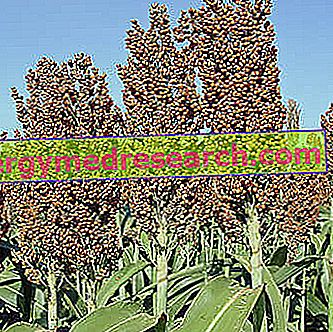Generality
Jam and jam are preserved foods based on fruit, sugar and food additives with a thickening and antioxidant action; etymologically, "marmellata" comes from the noun " marmelo", or the Portuguese name of the quince plant.

Knowing how to produce jam and jam at home is a great way to save money and reduce waste.
Home production
Jam and jam are the result of a real "food processing"; the traditional process is based on four key principles that include:
- Washing, peeling, cleaning the fruit and adding lemon juice to lower the pH of the food
- Fruit cooking with total water reduction, denaturation of the enzymes and solubilization of the viscous fiber
- Addition of thickening molecules:
- Sugar (sucrose or fructose) which also favors the dehydration of fruit pieces and has an important preserving function; however, the energy intake of jam or jam increases considerably
- Pectin (viscose fiber) that does not alter the energy intake from jam or jam and is also a prebiotic nutrient and useful for intestinal regularization. NB . The use of pectin is optional and can be replaced by large amounts of sugar, to the disadvantage, however, of the glycemic load of the food
- Injection into sterile under-vacuum capsules and storage in a suitable long-term environment.
First of all, to obtain the maximum solubility of the sugar, it is advisable that the pH of the jam and the jam is basically acid (less than 7); to do this, at home it is advisable to squeeze some lemon juice into the pieces of fruit before cooking or add it directly to the pan. Many believe that, by virtue of the content of vit. C, this ingredient also acts as an antioxidant in jam or jam; however, considering the long heat treatment to which they are subjected, it is likely that the ascorbic acid contained in the lemon juice is totally degraded by cooking the food.
The jam and jam are cooked in an aluminum saucepan (or in a copper pot) with the help of a lid. It is a very slow treatment (from 2-3 to 6-7 hours), which takes place at moderate intensity (low flame and use of the flame spreader), during which it is necessary to continuously mix the contents. PLEASE NOTE: the addition of pectin or special commercial gelling mixtures reduces cooking times to a few minutes, preserving the nutritional and organoleptic characteristics of fresh fruit, and avoiding excessive cooking with caramelization of sugars.
By virtue of the considerable chemical and nutritional difference of the various types of fruit, each jam or jam requires: cooking times, doses of sugar and doses of pectin also very different from each other.
It is important to reiterate that jam and jam reach a tied and homogeneous consistency thanks to the reduction of water, the dilution of sugar and the thickening function of pectin. The latter, which is a type of viscous fiber naturally contained in many types of fruit (especially apples, pears and citrus fruits), dissolves with cooking and thickens at room temperature. To improve the potential thickener of jam and jam, rather than increasing the doses of sugar, it is always advisable to increase the concentrations of pectin using a special ingredient available at any grocery store or supermarket.
The pectin contained in jams and jams is a striking example of how the word "food additive" is often misinterpreted by the consumer; this molecule, although artificially added, is a totally natural element commonly found in many fruit and vegetable products.
And now a theoretical and practical video recipe for making strawberry jam (or more correctly jam) at home
Strawberry jam - how to prepare homemade jam
X Problems with video playback? Reload from YouTube Go to Video Page Go to Video Recipes Section Watch the video on youtubeOther Video Recipes on Homemade Jam: Blackberry and Vanilla Jam - Melon Jam - Green Tomato Jam - Fig Jam
| Nutritional composition of Jams, (normal and live fruit type) - Reference values of INRAN Food Composition Tables | ||||||||||||||||||||||||||||||||||||||||||||||||||||||||||||||||||||||||
 | ||||||||||||||||||||||||||||||||||||||||||||||||||||||||||||||||||||||||
| Nutritional composition for 100 grams of edible portion Jams, (normal and live fruit type): | ||||||||||||||||||||||||||||||||||||||||||||||||||||||||||||||||||||||||
Nutritional values (per 100 g of edible portion) | ||||||||||||||||||||||||||||||||||||||||||||||||||||||||||||||||||||||||
| ||||||||||||||||||||||||||||||||||||||||||||||||||||||||||||||||||||||||
Finally, to obtain a long-life product, it is necessary to: wash or rinse the capsules thoroughly, sterilize them in boiling water and immediately fill them with jam or jam at very high temperature; in this way, in addition to guaranteeing the absence (or almost) of the micro-organisms inside the jars, tightening the caps and turning them upside down on a cold surface will make it possible to obtain an excellent vacuum.
It is therefore necessary to preserve the jam or jam in a dark, dry, ventilated pantry with a temperature that fluctuates around 18-20 ° C.
Blackberry jam
Blackberry jam is one of the most popular recipes but also the least indicative; it does not require the addition of pectin and reaches a decidedly solid consistency even only by cooking with sugar. It is however possible to drastically reduce the intake of sucrose by adding pectin, obtaining a further reduction in the total caloric intake and shortening the cooking time.
Ingredients : 1000g of blackberry, 300g of sugar.
Procedure : wash the blackberries, pass them and mix the sugar content. Cook over low heat, stirring occasionally until it reaches the right consistency; meanwhile, wash and sterilize the capsules. Fill the capsules with the boiling mixture and turn them upside down; let it cool down.
The procedure for making blackberry jam at home is illustrated in this video recipe.
Nutritional characteristics
Jam and jam are very sweet foods, although some dietary types have recently been put on the market, as they have no sugar ADDED. Unlike fresh fruit, due to prolonged cooking, jam and jam are poor in thermolabile vitamins and antioxidants. The amount of fiber and mineral salts remains almost unchanged, as well as that (although insignificant) of proteins and lipids.



